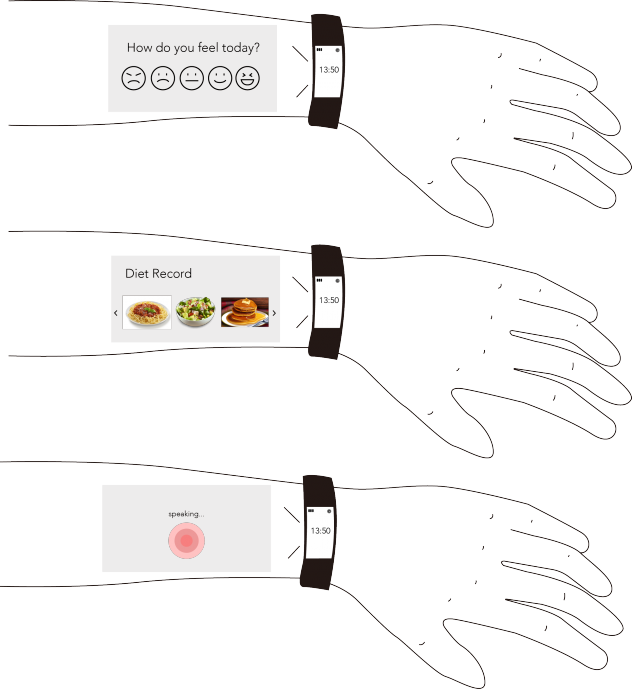After the planning, I started doing my prototype. My product had two requirement — the installation that can detect user’s biometric data and the A.I. conversation system.
I made a smart watch which was used to record user’s data, for instance, blood press, heartbeat, walking distance, sleeping quality, and calories. The data would stored in cloud and your A.I. health system, which I called her “Lora”, could use the data and analyze your condition. Based on those data, Lora could give user some advices and recommends.
As mentioned previously, the main difference of Lora, comparing with existing smart watch, was she could talk to user like a normal people and gave you advice based on not only your body condition as well as your state of mind.
Story Board
Janet is a 30 year-old office lady, who is busy working on her job everyday. As usual, Janet gets off work at 7:30 PM, with exhausted condition, she decides to grab some fast food and go back home. When she gets home, she can finally enjoy a bottle of wine and a cigarette in her cozy studio.
Janet’s life has changed since she met Lora. Lora is an artificial intelligence robot. When Janet comes back, Lora starts chatting with her and ask her how she feel about today. Janet feels sweet because there is a person who can talk with. Perhaps, because Lora is a robot, Janet can feel more free when talking to her, because robot won’t give her moral judgement. Besides chatting with her, Lora encourages Janet to change some action in her daily life in order to get healthy body.
Behind the scenes, Lora’s conversation is generated by algorithm based on Janet’s biometric and body condition, which is transferred from the smart watch on her wrist. Besides, Lora tracks Janet’s browser history and interaction on the internet, in order to observe her mental and emotional state.
Through everyday informal conversation and relationship as friend, Janet takes Lora’s advices and makes some changes in her life now. She chooses to eat fresh salad and sandwich instead of fast food, having two no-cigarette day every week. She does meditation and yoga with Lora during no-cigarette day. Through the process, Janet feels much more better, mentally and physically. The A.I. system like Lora can help people reduce the risk of stroke, heart attack, and chronic disease such as diabetes and high blood press.
Testing
I did testing for two people, and they gave me some feedbacks:
- I can’t not see big difference from existing products
- Why I have to use watch and cellphone, why can’t they combine? Too many devices are annoying
- More specific user (e.g., Diabetes patient)
According to their feedbacks, the first point, I though it was because my video prototype was not able to convey the ideal concept of Lora. That’s why they thought it looked similar with Siri, iWatch and some existing product. For the second advice, it was a very good thought. I found a precedent that bracelet could project a touchscreen on directly.
(img source: http://www.dailymail.co.uk/sciencetech/article-2871401/The-bracelet-turns-ARM-touchscreen-Cicret-projects-emails-videos-games-skin.html)
Change
Besides, I was thinking maybe A.I. was able to give prescription to user if they were sick. Based on the collected biometric data, if A.I. discovered the sign of illness, apart from giving daily advises, A.I. could gave the prescription just like what doctors do when they analyze patients. Biometric data won’t lie, as long as A.I. could detect the symptom correctly, this function would help lots of people.



Leave a Reply